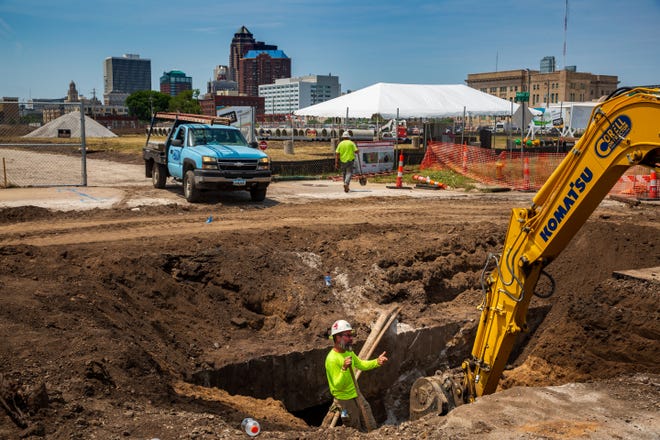
Spurred by unusual growth in the construction sector, a hiring boost in January sent Iowa’s payroll employment above its pre-pandemic level for the first time, according to federal data released Monday.
Payrolls in the state increased by 8,300 during the month, a second straight month of job growth for Iowa. The state’s unemployment rate remained flat at 3%, ranking 17th among states but lower than the U.S. average of 3.4% in January.
The state exceeding its pre-pandemic payroll count for the first time carries symbolic significance. As of January, according to the federal data, Iowa employers had about 1.6 million total workers. That’s about 2,300 more on Iowa payrolls than there were in February 2020, a month before the state required many businesses to close to slow the spread of COVID-19.
Iowa Workforce Development Director Beth Townsend did not address the marker in a statement about the latest jobs report Monday. The department has been comparing its post-pandemic job growth to March 2020 data, which federal surveyors collected days before government officials declared COVID-19 a public health emergency.
By that measure, Iowa already had surpassed that mark, However, employers around the country ― and in Iowa ― were already shedding employees before the government declaration that led to widespread workplace shutdowns and a sharp but brief recession.
In her statement, Townsend credited January’s job growth to an initiative that Iowa Workforce Development launched last year. In the Reemployment Case Management program, staffers are supposed to frequently meet with unemployed workers, helping them write resumes, submit applications and find job fairs.
“Iowa has worked hard over the last year to make it easier to connect Iowans with open jobs,” Townsend said in a statement.
The state’s economic growth in January was led by construction companies, which added about 3,900 workers during the month. The winter construction hiring is a rarity in Iowa, where below-freezing wind chills at the start of the year often lead to construction project pauses and layoffs.
Prior to 2023, Iowa lost jobs in the construction sector in five out of six years. The state lost an average of 380 construction jobs during those six years.

In addition to the construction sector, employers in the health services sector added 1,300 workers in January. Nondurable goods manufacturers like meatpacking plants and corn mills added 1,200 employees.
Meanwhile, the number of Iowans reporting that they were unemployed decreased by 1,200 in January, according to the data. But the size of the labor force ― the people who have jobs or are looking for them ― also dropped, by 1,700.
How does Iowa’s economic recovery compare to the rest of the country’s?
Iowa is seven months behind the country overall: U.S. employers surpassed their pre-pandemic payroll head count last June, according to the U.S. Bureau of Labor Statistics.
Since May 2020, when companies began rehiring workers after mass layoffs in the first month of the pandemic, Iowa employers have recovered 101% of the jobs that they shed. In the country overall, employers have recovered 112% of the jobs.
The future of the hiring spree is uncertain. It’s defied expectations, and some economists forecast a recession later this year, as the Federal Reserve attempts to slow the 41-year-high pace of inflation by increasing interest rates. The Fed’s move will discourage companies from borrowing money, cancelling some previous expansion plans, the economists predict.
How has Iowa’s economy changed in the last three years?
With the January hiring, construction jobs are now the leading employment growth in Iowa since the start of the pandemic.
The sector’s 3,900 new jobs in January more than doubled the number of hires in the sector from March 2020 through December 2022. It brought growth in total employment by construction companies to 7,200 since the beginning of the pandemic.
Nondurable goods manufacturers had the second-biggest growth among employers in Iowa during the period, adding 3,900 workers. Education services added 3,000 jobs. Management added 2,900 jobs. Professional, scientific and technical services added 2,700 jobs.
On the other side, the health services sector has lost the most workers, shedding 4,600 jobs since the start of the pandemic. Accommodation and food services and local governments shed 3,200 jobs apiece. Durable goods manufacturers shed 2,500 jobs.
Tyler Jett covers jobs and the economy for the Des Moines Register. Reach him at [email protected], 515-284-8215, or on Twitter at @LetsJett.






